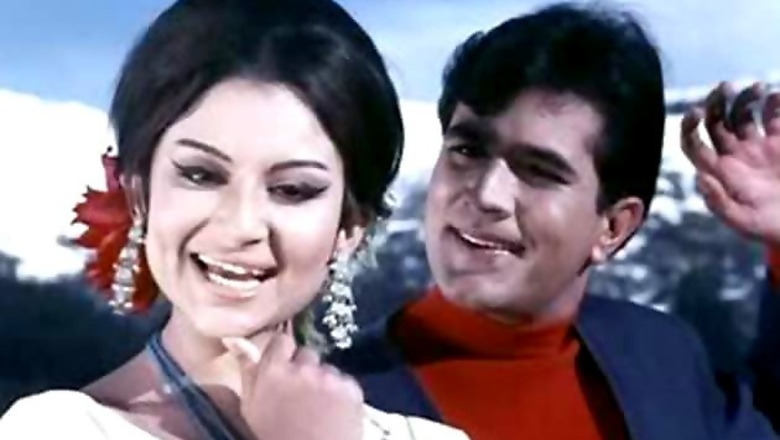
views
New Delhi: First things first….. no it has not been initiated by demise of Rajesh K . It has been said that the history of cinema is also a history of exciting, adventurous and celebrated love affairs. Dead right. And for excellent reasons.
The very nature of film making provides the mood and milieu for two people thrown together, for continuous amorous encounters between them. Far off Switzerland or neighboring Goa, their close and constant physical contact with each other often begins to lead on (and off the sets) to the romantic intimacies of the screenplay.
Then again, they have an exclusive, subliminal and indefinable psychological bond. Idolized and damned, in equal measures, these larger-than-life creatures fall upon each other for fulfillment, leading them to believe (with some truth) that only one star can truly understand, relate and love another. But how does love surface in the first place? And what does this divine madness do to screen lovers? Does it actually help them emote better?
According to many distinguished people who pass their life and times tossing educated opinions on screen love in Bollywood, Dilip Kumar, Raj Kapoor and Dev Anand were the greatest. Let’s take Dilip first. In an environment filled with hammy overacting, Dilip was perhaps the first actor in Bombay to introduce the rare, dignified and yet powerful element of restraint. And this element naturally, crept into his love scenes.
The Dilip-Madhubala, Dilip-Vyjayanti, Dilip-Meena, Dilip-Waheed teams, have love scenes fashioned by the wonderfully refreshing trait. A quiet, intense, sensitive (often to the point of shyness) lover who very nearly doesn’t make it. The near-lover, the puzzled introvert – these are some labels that come to mind while recollecting Dilip and his intense version of one from the heart.
In total contrast was the Raj-Nargis team. Loud, boisterous and always full of life and laughter, this team brought in their love-scenes a daring and pizzazz which was completely Western in concept and unknown in popular Indian cinema before. The Raj-Nargis love scenes were very passionate, very beautiful and often very physical. The heady fever comes through loud n’ clear when you compare Devdas, Daag and Paigham with Barsaat, Awara and Shree 420, Raj and Nargis really did things with their love scenes and one has to think very hard indeed to match another couple who set any generation ablaze as they did.
If Dilip and his heroines brought intensity, sensitivity and restraint in their love-scenes, Raj-Nargis, passion, boldness and undiluted physicality – then Dev Anand of the nodding head, tossed out ‘contemporariness’ to the mobs. Neither too serious nor overtly passionate, they brought in style, Chaal, Ada every time he ‘pharmaoed’ ishq. From Suraiya to Tina Munim – Dev’s love scenes (Manzil, Paying Guest, Jab Pyaar..., Asli Nakli, Guide, Des Pardes) have always been sprinkled with rare flamboyance. His style of talking, walking and mannerisms have turned-on not only his heroines, but millions of adoring fans down the decades. Oh, there was Guru Dutt too, who blazed with all cylinders firing and lit up the screen with lady love Waheeda Rehman in classics like Pyaasa, Kagaz Ke Phool, Chaudvin Ka Chand, Sahib Biwi Aur Ghulam, but his was a different scene.
Interestingly, all these big-dads emoted much better (as their films reveal) when in love and deeply entrenched in their heroine’s soul. The only REAL inheritor of their legacy was Rajesh Khanna, who in the early seventies brought back love [in all his crinkled eyed glory] to where it belonged - center-stage.
Today, in year 2012, Shah Rukh Khan and Kajol may well be voted the “most romantic couple of the day” through an opinion poll and DDLJ, their “all time favourite movie”, but somehow, it isn’t the same … Pure, raging, insane, passion – love that you could die for – has been replaced by love parading as a designer emotion, a fashion statement, fun n’ cool, with sensuous body language in place of the inarticulated expressions of love, loss and longing … Further, today, in a world where ‘speed’ is the watchword and ‘quantity’ the cardinal turn-on, love has become a publicity gimmick, a marketing tool, a selling force often [at the joint instance of stars and producers] designed to psyche and hustle the turned-on mobs into a storming a movie.
As can be gathered, this blitz is normally machine-gunned before the release of a film. What these dumbbells don’t understand is that publicity can’t sell a lousy movie. Nor can curry-dipped rumours. At most they can create a climate of excitement which, however, could – and does – dangerously boomerang if the promise does not match the performance.
At the time of writing, new star-teams are caught in the spectacular race for box-office buzz. Are they only confirming the obvious: that the world of passion and intensity has been replaced by hype and heart-string manipulators, panting to get into the fast lane, at any cost?
Not everyone agrees.
“I totally disagree. I don’t buy the idea the environment in earlier times – Stars, movies, individuals – were more romantic than ours.” That is bollywoods new, blazing love-guru, director Imtiaz Ali, Who’s JAB WE MET and LOVE AAJ KAL seemed to have zonked the masses.
“ The passion and intensity of love, loss and longing that you speak about is still around – it could, for example, well be a man sitting in a café, sipping coffee by himself, cheerful, bullish on life, doing his crossword. Suddenly, we see tears rolling down his cheeks. There could be a zillion reasons, only the manifestations are different. These are complex times and the trappings, idiom, style and manner of expressing love, feeling and emotion has changed to keep pace with it. The REAL thing, however remains intact.”
The inimitable Gulzar comes next. I go along with Imtiaz and don’t think it is all true, although [partially] it seems so. I feel it’s a completely time and place things. The long drawn romance born of rishtas that came from different cities, defining the distance-lends-enchantment factor in todays’ life belongs to the fiction category.
The tremulous meeting of eyes, accidental brushing of hand leading to unspoken, inarticulated, romantic highs doesn't happen any more. That was then … the fifties. In year 2012, it is a more pro-active, informal and direct interface between young men and women living in a world dominated by internet, Cell phones and ATMs. It’s a generational thing, That’s the way the young people conduct romance today… and I go along with it all the way.”
Ah well, but dear reader you might like to pause and reflect on this as well…
Once upon a time, love was romance. Dilip holding his Queen of Hearts protectively in his arms, while his eyes blazed defiance at his royal father; Raj embracing his woman passionately: Dev prancing around with his lady love.
All that resides in the fluffy soft focus of a distant past. Today, love appears to be less of a sublime emotion, more of a consumer perishable along the FMCG line. To be clinical is to be in. Increasingly, the primacy of permissiveness has replaced love with sex, corrupting into an act, a behavior, an ingredient so artificially (and seductively) relevant that film-makers have appointed themselves as lab-specialists. They have detailed, magnified and celebrated titillation in the mainline commercial – and in doing so, destroyed emotion, buried passion, corrupted intimacy, killed charm and de-mystified romance…forever.
And the loss remains completely ours…

















Comments
0 comment